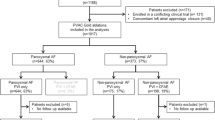Abstract
Atrial fibrillation (AF) is the most common arrhythmia experienced in clinical practice (approx. 1% predominance in the adult population). Unfortunately, long-term efficacy of antiarrhythmic drug therapy is disappointing and could cause serious side effects. Radiofrequency (RF) catheter ablation has emerged as an important therapeutic option for drug refractory patients. However, the development in ablation strategies remains complex with often lengthy procedures. This study investigates whether a novel multielectrode catheter, delivering duty-cycled bipolar/unipolar RF energy, is feasible and safe. Therefore, 81 consecutive patients with paroxysmal or persistent AF has been analyzed. Pulmonary vein isolation with the pulmonary vein ablation catheter was safe with short fluoroscopy/procedural time and good clinical efficacy at 6 months (stable sinus rhythm in 78% of patients).



Similar content being viewed by others
References
Go AS, Hylek EM, Phillips KA, Chang Y, Henault LE, Selby JV, Singer DE (2001) Prevalence of diagnosed atrial fibrillation in adults national implications for rhythm management and stroke prevention: the Anticoagulation and Risk Factors In Atrial Fibrillation (ATRIA) Study. JAMA 285:2370–2375
Benjamin EJ, Wolf PA, D'Agostino RB, Silbershatz H, Kannel WB, Levy D (1998) Impact of atrial fibrillation on the risk of death: the framingham heart study. Circulation 98:946–952
Boersma L, Mulder A, Jansen W, Wever E, Wijffels M (2009) Voltage analysis after multi-electrode ablation with duty-cycled bipolar and unipolar radiofrequency energy: a case report. Europace 11;1546–1548
Calkins H, Brugada J, Packer DL, Cappato R, Chen SA, Crijns HJ, Damiano RJ Jr, Davies DW, Haines DE, Haissaguerre M, Iesaka Y, Jackman W, Jais P, Kottkamp H, Kuck KH, Lindsay BD, Marchlinski FE, McCarthy PM, Mont JL, Morady F, Nademanee K, Natale A, Pappone C, Prystowsky E, Raviele A, Ruskin JN, Shemin RJ. for the HeartRhythm Society, European Heart Rhythm Association, European Cardiac Arrhythmia Society, American College of Cardiology, American Heart Association, Society of Thoracic Surgeons (2007) HRS/EHRA/ECAS Expert consensus statement on catheter and surgical ablation of atrial fibrillation: Recommendations for personnel, policy, procedures and follow-up. Europace 9:335–379
Cheema A, Dong J, Dalal D et al (2006) Long-term safety and efficacy of circumferential ablation with pulmonary vein isolation. J Cardiovasc Electrophysiol 17:1080–1085
Hocini M, Sanders P, Jais P et al (2004) Techniques for curative treatment of atrial fibrillation. J Cardiovasc Electrophysiol 15:1467–1471
Verma A, Patel D, Famy T et al (2007) Efficacy of adjuvant anterior left atrial ablation during intracardiac echocardiography-guided pulmonary vein antrum isolation for atrial fibrillation. J Cardiovasc Electrophysiol 18:151–156
Fredersdorf S, Weber S, Jilek C et al (2009) Safe and rapid isolation of pulmonary veins using a novel circular ablation catheter and duty-cycled RF generator. J Cardiovasc Electrophysiol 20:1097–1101
Wieczorek M, Hoeltgen R, Akin E et al (2009) Results of short-term and long-term pulmonary vein isolation for paroxysmal atrial fibrillation using duty-cycled bipolar and unipolar radiofrequency energy. J Cardiovasc Electrophysiol. Published Online: Nov 10 2009 11:29 AM DOI: 10.1111/j.1540-8167.2009.01640.x
Boersma L, Wijffels M, Oral H et al (2008) Pulmonary vein isolation by duty-cycled bipolar and unipolar radiofrequency energy with a multielectrode ablation catheter. Heart Rhythm 5:1635–1642
Scharf C, Boersma L, Davies L et al (2009) Ablation of persistent atrial fibrillation using multielectrode catheters and duty-cycled radiofrequency energy. J Am Coll Cardiol 54:1450–1456
Conflict of interest
The author declares that there is no conflict of interest.
Author information
Authors and Affiliations
Corresponding author
Rights and permissions
About this article
Cite this article
Spitzer, S., Karolyi, L. Catheter ablation of atrial fibrillation with a novel, duty-cycled ablation system. Clin Res Cardiol Suppl 5 (Suppl 1), 51–56 (2010). https://doi.org/10.1007/s11789-010-0011-1
Published:
Issue Date:
DOI: https://doi.org/10.1007/s11789-010-0011-1




